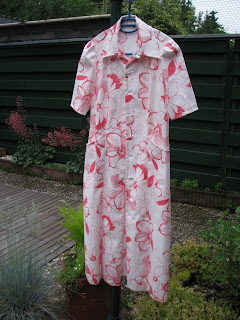As it happens I discovered only recently, at the age of 53 no less, that knee length dresses don't work for me because I'm short. So when that eye opening moment finally occurred I immediately started to shop for some new dress patterns.
This is the one I'm working on:
The design is a princess line with short sleeves, button down closure, and a collar with stand. The sleeves are gathered, but only at the the top. Needless to say they were very easy to sew, since there was no easing involved.
Much to my delight the collar with stand went quite well too. I was a bit worried because I never made a collar with stand before.
I've sewn one side of the collar stand to the dress with the sewing machine. The inner side, which is pinned in the photo, is going to be hand sewn.
Now that I'm looking at the photo I'm not sure whether I should have sewn the inner stand to the dress, thus having the hand sewing hidden by the collar when I wear the dress. I'll keep it in mind for the next dress, and try how it looks when I do it the other way around.
The pockets are a nice detail, I think.
This is a fun project overall. And several first times are involved, like making buttonholes, and a collar with a stand.This fabric, however was so cheap that I bought 6 meters of it. It's incredible, but the fabric cost only 1 Euro per meter, and the width is 1.40 m.!!! No wonder I didn't fret about making mistakes.
The dress is being sewn using the Pfaff and the Juki.









